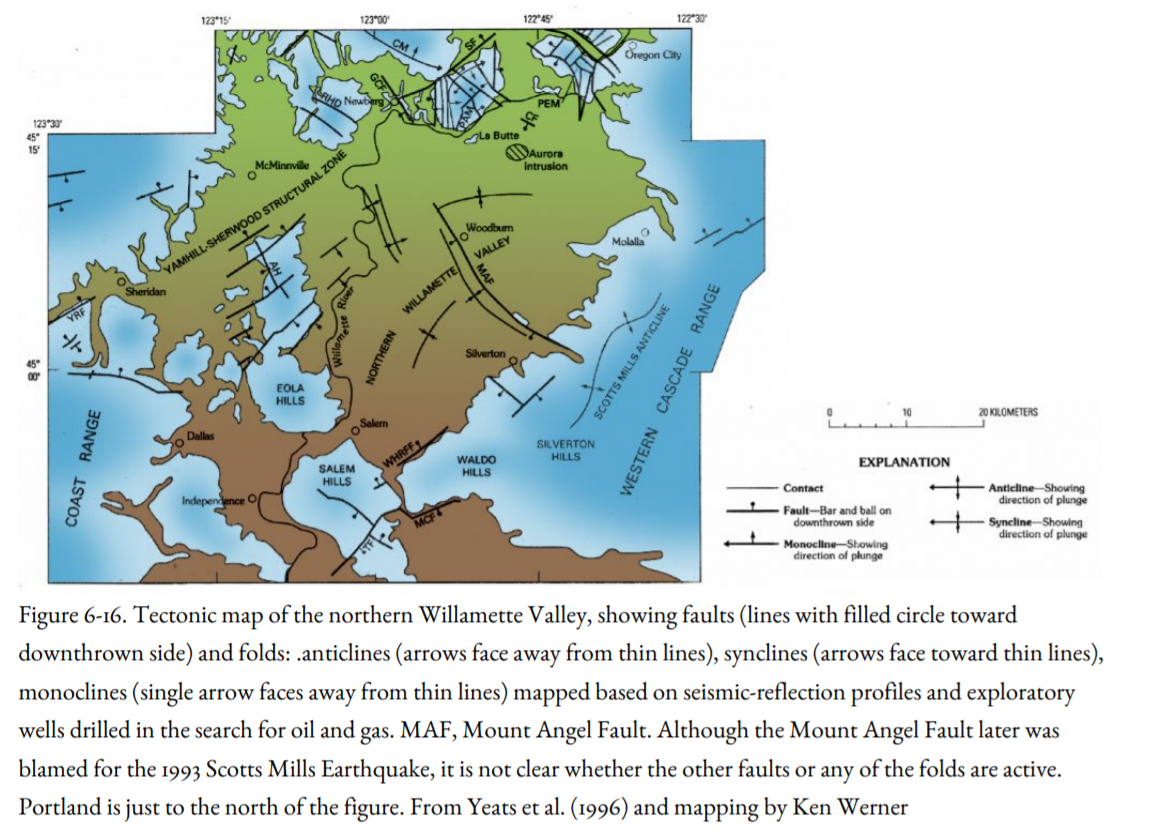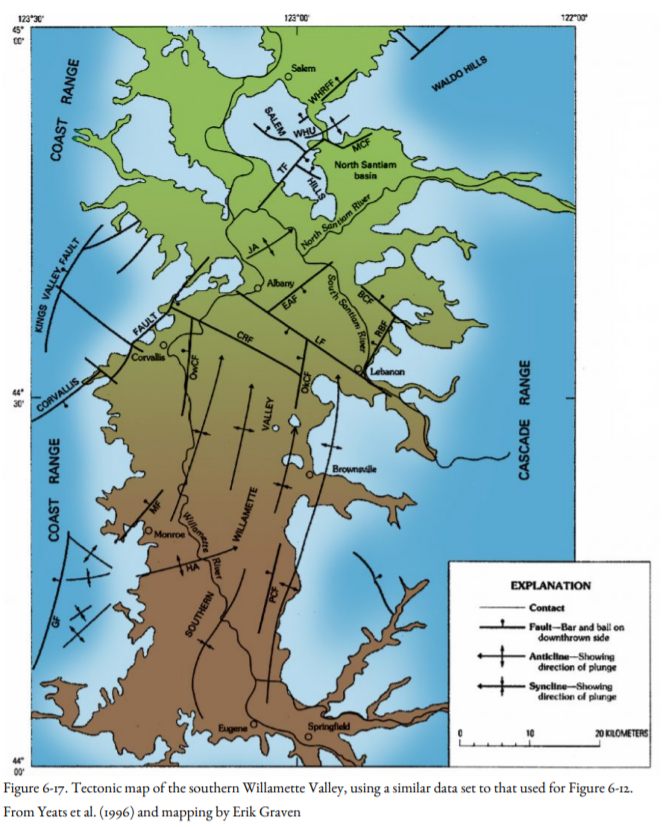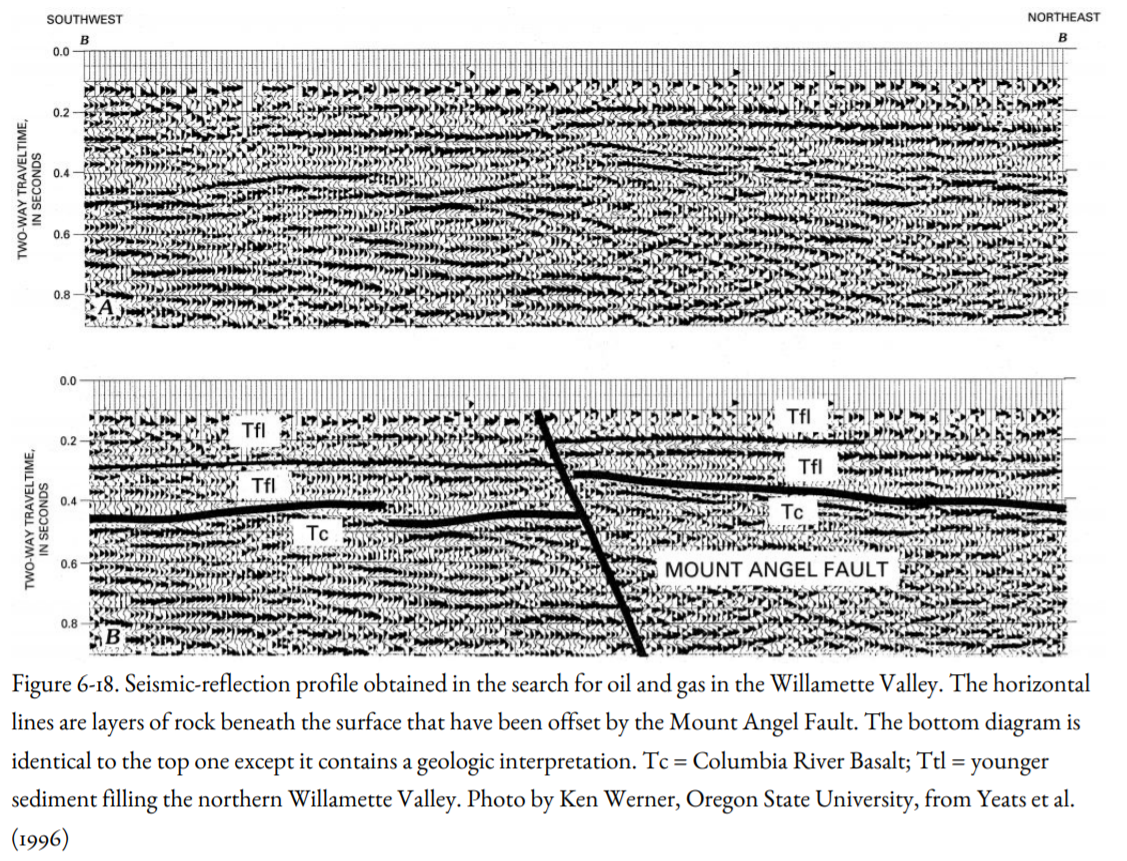5.6.6: Earthquakes at the End of the Oregon Trail (Willamette Valley)
- Page ID
- 5980
\( \newcommand{\vecs}[1]{\overset { \scriptstyle \rightharpoonup} {\mathbf{#1}} } \)
\( \newcommand{\vecd}[1]{\overset{-\!-\!\rightharpoonup}{\vphantom{a}\smash {#1}}} \)
\( \newcommand{\id}{\mathrm{id}}\) \( \newcommand{\Span}{\mathrm{span}}\)
( \newcommand{\kernel}{\mathrm{null}\,}\) \( \newcommand{\range}{\mathrm{range}\,}\)
\( \newcommand{\RealPart}{\mathrm{Re}}\) \( \newcommand{\ImaginaryPart}{\mathrm{Im}}\)
\( \newcommand{\Argument}{\mathrm{Arg}}\) \( \newcommand{\norm}[1]{\| #1 \|}\)
\( \newcommand{\inner}[2]{\langle #1, #2 \rangle}\)
\( \newcommand{\Span}{\mathrm{span}}\)
\( \newcommand{\id}{\mathrm{id}}\)
\( \newcommand{\Span}{\mathrm{span}}\)
\( \newcommand{\kernel}{\mathrm{null}\,}\)
\( \newcommand{\range}{\mathrm{range}\,}\)
\( \newcommand{\RealPart}{\mathrm{Re}}\)
\( \newcommand{\ImaginaryPart}{\mathrm{Im}}\)
\( \newcommand{\Argument}{\mathrm{Arg}}\)
\( \newcommand{\norm}[1]{\| #1 \|}\)
\( \newcommand{\inner}[2]{\langle #1, #2 \rangle}\)
\( \newcommand{\Span}{\mathrm{span}}\) \( \newcommand{\AA}{\unicode[.8,0]{x212B}}\)
\( \newcommand{\vectorA}[1]{\vec{#1}} % arrow\)
\( \newcommand{\vectorAt}[1]{\vec{\text{#1}}} % arrow\)
\( \newcommand{\vectorB}[1]{\overset { \scriptstyle \rightharpoonup} {\mathbf{#1}} } \)
\( \newcommand{\vectorC}[1]{\textbf{#1}} \)
\( \newcommand{\vectorD}[1]{\overrightarrow{#1}} \)
\( \newcommand{\vectorDt}[1]{\overrightarrow{\text{#1}}} \)
\( \newcommand{\vectE}[1]{\overset{-\!-\!\rightharpoonup}{\vphantom{a}\smash{\mathbf {#1}}}} \)
\( \newcommand{\vecs}[1]{\overset { \scriptstyle \rightharpoonup} {\mathbf{#1}} } \)
\( \newcommand{\vecd}[1]{\overset{-\!-\!\rightharpoonup}{\vphantom{a}\smash {#1}}} \)
\(\newcommand{\avec}{\mathbf a}\) \(\newcommand{\bvec}{\mathbf b}\) \(\newcommand{\cvec}{\mathbf c}\) \(\newcommand{\dvec}{\mathbf d}\) \(\newcommand{\dtil}{\widetilde{\mathbf d}}\) \(\newcommand{\evec}{\mathbf e}\) \(\newcommand{\fvec}{\mathbf f}\) \(\newcommand{\nvec}{\mathbf n}\) \(\newcommand{\pvec}{\mathbf p}\) \(\newcommand{\qvec}{\mathbf q}\) \(\newcommand{\svec}{\mathbf s}\) \(\newcommand{\tvec}{\mathbf t}\) \(\newcommand{\uvec}{\mathbf u}\) \(\newcommand{\vvec}{\mathbf v}\) \(\newcommand{\wvec}{\mathbf w}\) \(\newcommand{\xvec}{\mathbf x}\) \(\newcommand{\yvec}{\mathbf y}\) \(\newcommand{\zvec}{\mathbf z}\) \(\newcommand{\rvec}{\mathbf r}\) \(\newcommand{\mvec}{\mathbf m}\) \(\newcommand{\zerovec}{\mathbf 0}\) \(\newcommand{\onevec}{\mathbf 1}\) \(\newcommand{\real}{\mathbb R}\) \(\newcommand{\twovec}[2]{\left[\begin{array}{r}#1 \\ #2 \end{array}\right]}\) \(\newcommand{\ctwovec}[2]{\left[\begin{array}{c}#1 \\ #2 \end{array}\right]}\) \(\newcommand{\threevec}[3]{\left[\begin{array}{r}#1 \\ #2 \\ #3 \end{array}\right]}\) \(\newcommand{\cthreevec}[3]{\left[\begin{array}{c}#1 \\ #2 \\ #3 \end{array}\right]}\) \(\newcommand{\fourvec}[4]{\left[\begin{array}{r}#1 \\ #2 \\ #3 \\ #4 \end{array}\right]}\) \(\newcommand{\cfourvec}[4]{\left[\begin{array}{c}#1 \\ #2 \\ #3 \\ #4 \end{array}\right]}\) \(\newcommand{\fivevec}[5]{\left[\begin{array}{r}#1 \\ #2 \\ #3 \\ #4 \\ #5 \\ \end{array}\right]}\) \(\newcommand{\cfivevec}[5]{\left[\begin{array}{c}#1 \\ #2 \\ #3 \\ #4 \\ #5 \\ \end{array}\right]}\) \(\newcommand{\mattwo}[4]{\left[\begin{array}{rr}#1 \amp #2 \\ #3 \amp #4 \\ \end{array}\right]}\) \(\newcommand{\laspan}[1]{\text{Span}\{#1\}}\) \(\newcommand{\bcal}{\cal B}\) \(\newcommand{\ccal}{\cal C}\) \(\newcommand{\scal}{\cal S}\) \(\newcommand{\wcal}{\cal W}\) \(\newcommand{\ecal}{\cal E}\) \(\newcommand{\coords}[2]{\left\{#1\right\}_{#2}}\) \(\newcommand{\gray}[1]{\color{gray}{#1}}\) \(\newcommand{\lgray}[1]{\color{lightgray}{#1}}\) \(\newcommand{\rank}{\operatorname{rank}}\) \(\newcommand{\row}{\text{Row}}\) \(\newcommand{\col}{\text{Col}}\) \(\renewcommand{\row}{\text{Row}}\) \(\newcommand{\nul}{\text{Nul}}\) \(\newcommand{\var}{\text{Var}}\) \(\newcommand{\corr}{\text{corr}}\) \(\newcommand{\len}[1]{\left|#1\right|}\) \(\newcommand{\bbar}{\overline{\bvec}}\) \(\newcommand{\bhat}{\widehat{\bvec}}\) \(\newcommand{\bperp}{\bvec^\perp}\) \(\newcommand{\xhat}{\widehat{\xvec}}\) \(\newcommand{\vhat}{\widehat{\vvec}}\) \(\newcommand{\uhat}{\widehat{\uvec}}\) \(\newcommand{\what}{\widehat{\wvec}}\) \(\newcommand{\Sighat}{\widehat{\Sigma}}\) \(\newcommand{\lt}{<}\) \(\newcommand{\gt}{>}\) \(\newcommand{\amp}{&}\) \(\definecolor{fillinmathshade}{gray}{0.9}\)Overview
Fifty million years ago, northwest Oregon was a low coastal plain, with the shoreline close to the western edge of the present Willamette Valley, extending northwestward toward Astoria into what would one day become the Coast Range. East of the shoreline, rivers deposited clean sand, and in their floodplains were broad swamps and marshes, like the tropical Pacific coast of Guatemala today. Over the next few million years, the sand and the organic deposits of the swamps were slowly buried beneath younger deposits, and the organic materials began to turn into coal and generate natural gas. The rock layers containing the coal and the sand were tilted, folded, and faulted. North of the Columbia River, the buried swamp deposits of this ancient tropical coast would form the major resource for a coal mining industry in western Washington. South of the Columbia, the economic potential of these deposits was still unrealized.
Near the backwoods village of Mist, Oregon, Chuck Newell had a dream. As a geologist for Shell Oil Company and later as an independent consultant, Newell had slogged up the brushy creeks and barren clear-cuts of the northern Coast Range, and he slowly pieced together an idea about the hidden geologic structure. Maybe the gas from the swamp deposits had migrated into the river sand, now hardened into sandstone. Maybe there was a gas field beneath a broad-up arched anticline that Newell had mapped beneath the alder and devil’s club jungle of the Coast Range.
This seemed a far-fetched idea because no one had ever discovered commercial quantities of oil or gas in Oregon or Washington, despite nearly a century of exploration. However, Newell convinced Wes Bruer, his former classmate at Oregon State University and a geologic consultant for Reichhold Chemical Company, that the Mist Anticline might contain commercial quantities of gas. Reichhold had purchased the Phillips urea plant at St. Helens, Oregon, and the plant required about nine million cubic feet of gas per day as raw material feedstock for the production of urea. Accordingly, Reichhold was persuaded to drill a well, and the Mist gas field was discovered. Overnight, Oregon had a local source of natural gas, the first in the Pacific Northwest.
As soon as the word was out, lease brokers fanned out across the Willamette Valley talking to grass-seed farmers and timber owners. Geophysical trucks laid cable and geophones along country roads and through pastures for seismic surveys. Wildcat wells were drilled in the region from Hillsboro to Eugene.
Alas, there were no more Mist gas fields, and the oil and gas boom crashed as quickly as it had started. But left behind were all the seismic surveys and wildcat well logs, which illuminated for the first time the complex geology beneath the orchards and vineyards of the Willamette Valley, just as they had for the Puget Sound region to the north. There were folds and there were faults, including a fault extending along the northern foot of the Waldo Hills east of Salem, and another passing beneath the Benedictine abbey at Mount Angel (Figures 6-16 to 6-18). These faults had been discovered in the search for oil and gas. Could they be an earthquake hazard?



Ken Werner, a graduate student at Oregon State University, collected the seismic surveys and well logs and mapped a subsurface fault extending from the Waldo Hills northwest beneath Mount Angel to the city of Woodburn near Interstate 5. In 1990, while Werner was working on his thesis research, seismologists John Nábelek of Oregon State University and Steve Malone of the University of Washington told him about a flurry of small earthquakes they had just recorded beneath Woodburn. Werner concluded that these earthquakes were related to the subsurface Mount Angel Fault (Figures 6-16 to 6-18). In September 1992, Werner and his colleagues published a paper in Oregon Geology, a journal published by the Oregon Department of Geology and Mineral Industries, with a map of the fault and a discussion of the Woodburn earthquake swarm. Unknown to Werner, the strain had been building up on the Mount Angel Fault beneath the Waldo Hills southeast of Woodburn and was already near the breaking point. The rupture came without warning six months later, at 5:34 a.m. on March 25, 1993, ten miles beneath the soft green hills east of the village of Scotts Mills, at the east edge of the Willamette Valley. In Molalla, eight miles north of the epicenter, José Alberto Nuñez felt the powerful rumbling and watched as his kitchen cabinets blew open, scattering glassware and dishes onto the kitchen floor. To the night crew at the Safeway store in Woodburn, fifteen miles northwest of the epicenter, the earthquake was a ground wave rolling beneath the floor, spilling out merchandise aisle by aisle. Ricky Bowers was driving across a bridge on State Highway 18 over the Yamhill River at Dayton, twenty-five miles away, when the bridge jumped off its supports, causing him to slam into the exposed concrete slab, blowing out all four of his tires. Fortunately, students were on spring break at Molalla Union High School, an unreinforced brick building constructed in 1925, where two gables on the exterior façade collapsed. The timing of the earthquake prevented serious injury to students, and school officials had only to worry about where classes would be held the following week. A block away from the school, Philip Fontaine ran out into his front yard, carrying his young son. “The children were all screaming. Everything was just shaking and not stopping.”
At Mount Angel, ten miles to the west, there was major damage to the Benedictine convent and training center, the Benedictine abbey, and St. Mary’s church and school.
Commercial buildings in the historic downtown district of Woodburn were hit hard. Sharon Walsh, the caretaker of the 102-year-old Settlemier Mansion, cowered as the house creaked and heaved, cracked and twisted, and she braced herself for a collapse. José Nuñez made it to his office at the Salud Medical Center in Woodburn only to find it in a shambles, with a gaping hole in the ceiling. In the town of Newberg, twenty-eight miles northwest of the epicenter, at least ninety buildings were damaged.
The State Capitol building in Salem, twenty-one miles away, had been declared vulnerable to an earthquake, with a price tag for seismic reinforcement of $4 million. The Legislature chose not to act. The earthquake produced cracks inside the rotunda, which was closed indefinitely. Concrete fireproofing on the steel I-beams supporting the ceiling of the legislative chambers was damaged. High atop the Capitol, the ten-ton statue of the Golden Pioneer rocked and lurched, rotating a sixteenth of an inch, but miraculously did not fall from its pedestal.
The damage was estimated at more than $28,000,000, with $4,500,000 to the State Capitol alone. (The ultimate cost of retrofitting the Capitol was later estimated at more than $67,000,000!) Surprisingly, there were no deaths. Injuries were limited to those from falling glass and bricks and to some of the employees of a large Walmart store overcome by fumes from bottles and cans of garden chemicals that had crashed to the floor. Unreinforced masonry buildings suffered a disproportionate share of the damage. The timing of the earthquake was fortunate: early in the morning during the week of spring vacation, preventing deaths at the unreinforced Molalla High School building. The fortunate timing gave the earthquake its name: the Spring Break Quake. Losses would have been much higher if the earthquake had struck one of the larger communities of the Willamette Valley rather than a rural area in the foothills of the Cascades.
Former senator Ron Cease of Portland, a member of the legislature at the time, may have said it best: not being able to walk beneath the rotunda on their way to work had an educational effect on Oregon’s legislators in terms of earthquake hazards!
As shown in Figure 6-16 and 6-17, there are other faults in the Willamette Valley. The Corvallis Fault was mapped by Chris Goldfinger on the northwest side of the city of Corvallis in low hills slated for urban development. Despite considerable efforts, none of these faults can be shown to displace Holocene deposits (younger than ten thousand years). Accordingly, we cannot state that these faults are active. The faults can be marked on the maps of areas being considered for urban development, and developers, local government, and potential buyers can make up their own minds about the potential for fault rupture. If you were considering the purchase of a new house in the Willamette Valley, would you want to be told by the local government that your house would be built on or close to a major fault, even though it could not be said that the fault was active or not?


